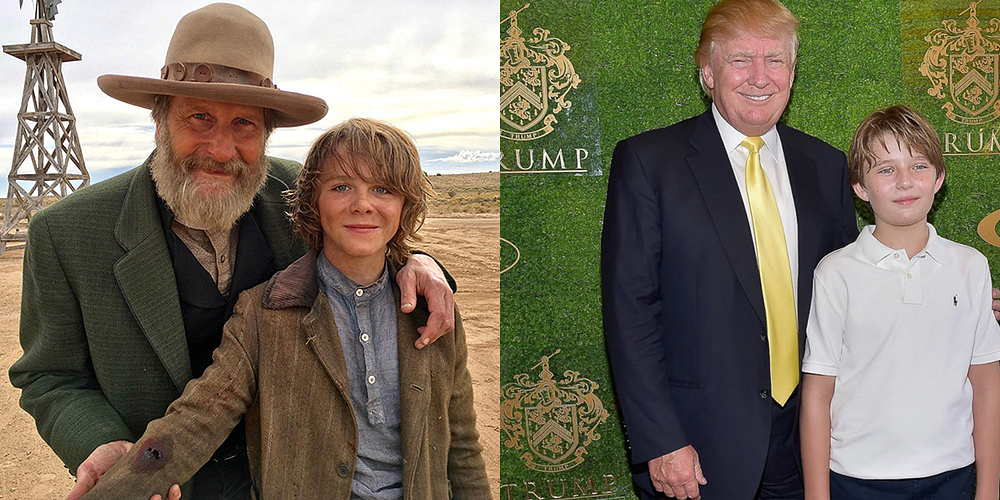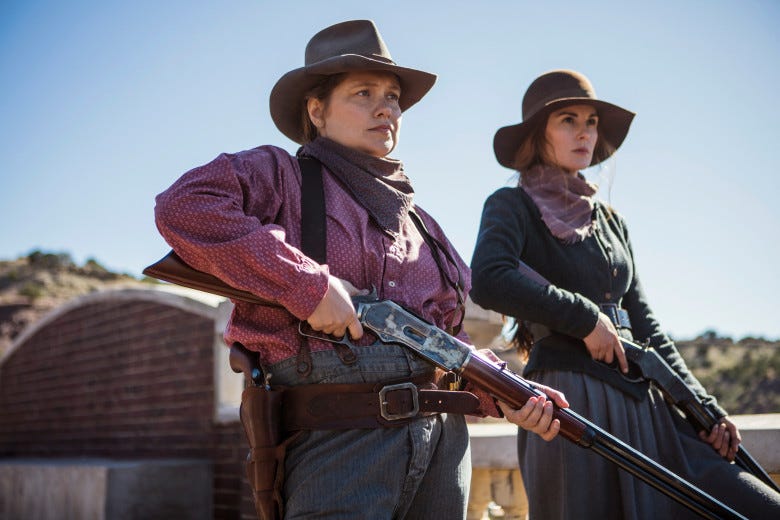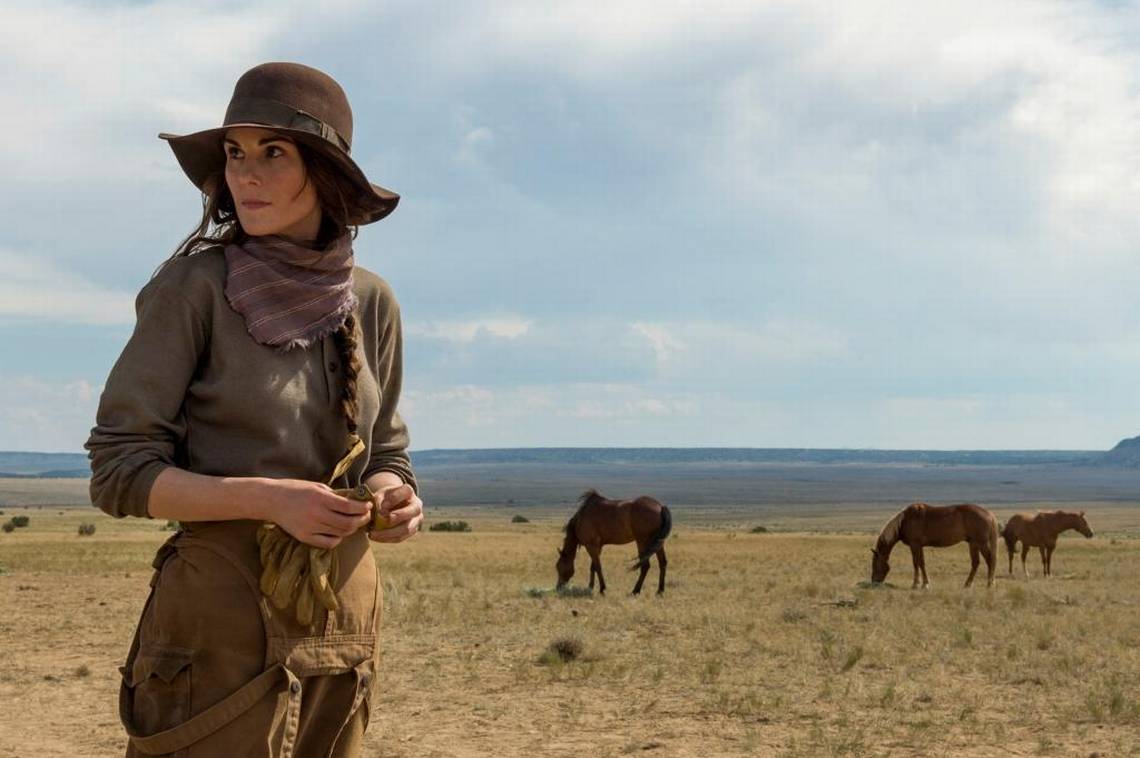Since the election of Donald Trump, it seems like our country has been in a never-ending debate about who we are and where we come from. There are so many places to look for answers but as a media critic, I, of course, look to TV. And in this moment of Bible-signing, border “crisis,” and macho, guns-out leadership, I find myself turning to Westerns for answers. They’re our own creation myth, the story of American exceptionalism, power, and whiteness.
Recently, there’s been some effort to update the Western with Netflix’s Godlessas the prime example. After all, it did win all those awards and premiere the same year as Trump’s presidency. I confess, my political leanings are such that I see some of Donald Trump in the show’s villain, Frank Griffin. The two men share a certain heaviness of body and jowls (sorry Jeff Daniels!). They also share a faux-Christianity that doesn’t require any respect for human life. And both of them are the type of leaders who collect crooks and lowlifes, seeing personal loyalty as the only meaningful virtue. I mean who would Michael Cohen et al. be in the old west but a band of gun-slinging outlaws? Am I right or am I right?

Of course, Frank Griffin and his men aren’t the only folks in Godless. The show’s marketing made quite the ado about its setting in a man-less town, positioning Godless as a feminist Western (which it is not). Certainly, there are strong women in the show. Michelle Dockery as Alice Fletcher is mesmerizing as the isolated widow with a good shot and mixed-race son. Her love life is central to the show, even as the creators betray in her a totally unnecessary and graphic rape scene. In it, we learn nothing new about the characters, already having learned that Alice has survived tough things. No, her rape is just an uncomfortable excuse to titillate the audience with Michelle Dockery’s breasts, combining violence with eroticism in a way that says MALE GAZE IS RAPE CULTURE in all caps.
And there’s my personal favorite, Merritt Wever as Mary Agnes, the town’s would-be leader who’s given up dresses and men as she holds her community together. Mary Agnes advocates for the women’s independence, urging her fellow townswomen not to make a business deal with partners who see their gender as weakness. In the finale, she organizes the women’s last stand, setting a strategy that will keep at least some of them alive. And along the way, we see her taking care of her brother’s kids and the hapless Thomas Brodie-Sangster as Whitey Winn. You see, Mary Agnes may have gone butch, even nabbing the richest, most beautiful and most experienced woman in town — Tess Frazer’s former sex-worker Callie Dunne — but the show takes great pains to let you know she’s still a nurturer and thereby a woman.

And these are the characters the show empathizes with — the white women of La Belle, New Mexico. Spoiler: People of color do much worse. Godless is clearly trying to rewrite the western to be less sexist and less white supremacist but when you’re counting degrees of racism, you’ve already lost. You see Godless relies on the same racist tropes that power the Westerns of the past, much of the media of today, and far too much of our politics, policies, and national conversation.
In Godless, we see a black town, literally called Blackdom, and its inhabitants as “others.” They’re introduced late (in episode three of seven) and portrayed as extremely violent in a violent world. You see the men of Blackdom (yes, I’m rolling my eyes each time I type the town’s name) are Buffalo Soldiers, black cavalry that fought with white, Anglo settlers in the Indian Wars. They weren’t guaranteed freedom from slavery even as they fought for white expansion — an interesting bit of history for sure. Yet, the show takes great pains to tell you these men were particularly ruthless and indeed we see the town’s leader beating his daughter with a switch. And that’s before all of the black characters are massacred in the wind-up to the real showdown: the white folks of La Belle vs the white folks in Frank Griffin’s gang. This is your typical racist use of black bodies and black stories.
Think that’s bad? Native American characters do not do better in Godless: they’re stuck in the magical sidekick trope, Native Americans who use their mystical powers to help the white people. There’s Duane Howard’s unnamed ”Shoshone brave” (his character name, not mine) who is maybe a ghost, maybe a vision, but either way exists to give Bill McNue encouragement and advice. And there’s Tantoo Cardinal’s Iyovi who uses her healing powers on the injured Roy Goode, who issues wise animal metaphors to guide her daughter-in-law Alice, and whose skills in hunting and other matters somehow serve as comic relief. Neither is what you’d call a humanizing portrayal.
Samuel Marty’s Truckee, the half Native American, half white, son of Alice only does a little better. He doesn’t have any magical skills or even propensity to “Indian” tasks like horseback riding. But he’s portrayed as a fish out of water, part of neither the white nor Native community, lost without a father or strong sense of identity. It’s the type of character that multiracial people have been rallying against for decades.
And last but not least is the show’s complete erasure of Latino characters. For a show set in New Mexico, it is odd that there is no one of mixed Spanish and Native descent. In fact, despite the action going to Taos and other Hispano centers in the area, we do not hear a word of Spanish, and there are no Latino characters. It’s a gross oversight that erases New Mexico’s past and present with a single casting decision. And in case you think the show reflects some actual moment in history — it does not. Godless takes place in the 1880s, a time when Anglo settlers were stealing land from Hispanos all over the state. None of that exists in Godless. We just see English-speaking White and Black people carving out a living in tough land, fighting with each other, and occasionally referencing offscreen Native Americans as menaces. It’s racist and completely inaccurate.
At the end of the day, the central conflict in Godless is between Jeff Daniels’ Frank Griffin and Jack O’Connell’s Roy Goode as they solve their differences with bullets, killing whole towns along the way. You see the women of La Belle, even the mighty Alice and Mary Agnes, are just the scenery for these two white men. So are the POC who manage to find their way on screen. And this is a Western trying to be progressive!
So when I look to Westerns to understand this moment in American history, it’s not for accuracy. The true story of the American West is a mix of germ warfare and white supremacy used to steal Native land first by Spaniards and then by Anglos. The heroes are not white guys with guns. They’re Native Americans fighting for their way of life. The villains aren’t white bandits. They’re white soldiers and lawmen who rigged the system and used their guns to ensure the existing population couldn’t overcome their cheating ways. But we don’t tell this story.
No, Westerns are not a view into our past but rather our present, how we got to the terrible place we’re in: centering white men, their experiences, and preoccupations to our peril. This false narrative about America and our birth in the West is hurting us all. It pushes the real story out of the frame, limits the personhood and agency of the vast majority of the population, and leads to seeing white toxic masculinity as the only viable model of leadership (looking at you Donald T).
Here’s hoping we can imagine a better past, present, and future. I’ll be reading the tea leaves, looking for a critically acclaimed Western that doesn’t center white men. Who knows? It could happen, but for now, I’m not holding my breath.

